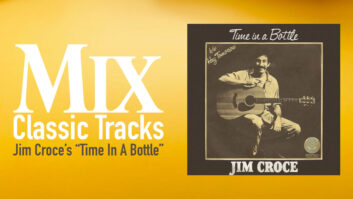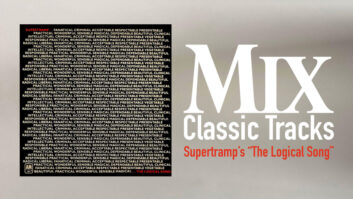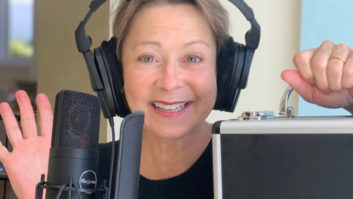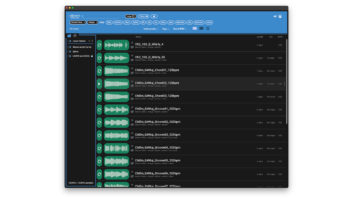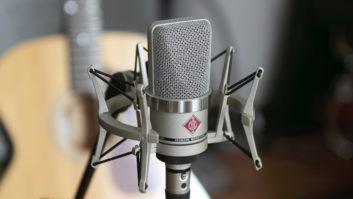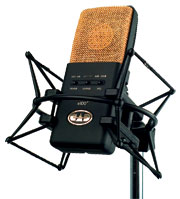
CAD EQUITEK E1002
Condenser Microphone
After a too-long absence, CAD’s popular Equitek studio condenser series is back. The first mic in the new Equitek Series is the e1002, a supercardioid electret.
The e1002 has a side-address body with a brass-plated stainless grille protecting the medium-diameter capsule. The front panel has switches for a -20dB pad, 80Hz LF roll-off and power. Like its predecessors, the mic uses internal batteries to provide more current than phantom power alone, and automatically recharges the batteries whenever phantom is applied. Fully charged, it can run six hours without phantom power — great for DAT recording or sampling in the field.
The mic retails at $399, with shock-mount. The latter is elaborate, and putting the mic in/out is a chore due to the tight access to the locking screw and its fine threads. A heavy yoke cradles the mic body, and if the mic is tilted back more than 10 degrees, the yoke contacts the suspension ring, thus defeating the purpose of the shock-mount. Also, when in the mount, access to your cable’s XLR unlock button is difficult. [Note: At press time, CAD was working on a solution for this — Ed.] However, the capsule’s internal suspension is very effective, so using the mic’s standard swivel mount is perfectly acceptable in nearly all applications. The swivel mount ships with the locking screw in backward (!); unless you insert it the other way, mic positioning is limited to 45 degrees rather than 180-degree rotation.
So with an upright shock-mount or with (reversed screw) swivel, I dove in. The mic’s tight supercardioid pattern offers great isolation, but requires vocalists to stay mostly on-axis. (The off-axis response is consistent, but if you get too far off-center, the level drops.) The mic remains flat throughout most of its range (HF rises gently between 6k and 10k Hz) — just right on female vocals. Male vocalists needed a bit of upper MF boost (between 4 and 6 kHz) for a bit more punch — my preference here is for CAD’s M9 tube mic, which has a more aggressive sound on male vocals. The proximity effect was slight: The mic sticks to its mostly linear character without LF muffling or undue boominess.
On toms, the mic’s 148dB handling was an asset (as was the tight pattern) and the sound was smooth and round, but with a nice attack. On kicks, it sounded very RE-20 to me — you’ll have to do EQ shaping on rock kicks, although it’s just the thing for a woolly jazz sound. On overheads, response was natural and airy, with clean upper transients. Sax was nice — smooth and not edgy at all.
Once past a few shock-mount issues, the e1002 is a versatile studio mic and its affordable price makes a good argument for buying two.
CAD Professional Microphones, 800/762-9266, www.cadmics.com.
— George Petersen

GROOVE TUBES THE BRICK
Preamp/Direct Box
The Brick is a single-channel, all-tube DI/mic preamp that combines top performance with a low $499 MSRP. Essentially Groove Tube’s Ditto DI with a mic preamp, The Brick is housed in an all-steel cabinet with nearly all of the components manufactured by Groove Tubes. Besides the built-in 110/220 VAC power supply, there are three Groove Tubes (6205, 12AX7 and 12AU7) running in cascade Class-A mode for up to +30 dB of gain for the instrument input and +55 dB for the XLR mic input.
Its custom-wound I/O transformers are almost too big to fit in the cabinet. Controls include master gain level and switches for AC and phantom power (with LED indicators) and instrument ground lift. I/Os include ¼-inch 3-megohm impedance instrument input and feed-thru jacks, a 600-ohm XLR mic input (great match for ribbon mics) and balanced 150-ohm line-level XLR out.
In the studio, recording direct guitar out of a pedal board, The Brick’s output went directly to a line input on the studio’s Neve 8058 console. With The Brick’s gain knob at 3 o’clock, the 1073 module’s line switch to the +10dB position, I got a 0dB fader position and full level to the Pro Tools|HD rig (-18dB ref.). The sound was excellent: clear, present with no noise and smooth highs. The Brick was out of reach in the studio, so if I didn’t require local control, I could have bypassed the Neve and connected The Brick directly to the Digidesign 192 I/O, which I did when recording vocals and bass guitar.
I got great vocal sounds from a loud and slightly shrill rock singer. Even my cranky U87 sounded warm and fuzzy, but I had to wind the gain control nearly wide open to achieve a proper recording level. With 55 dB of gain, The Brick is fine for about 90 percent of recording tasks. If you’re doing quiet Foley or ambient recordings, or using low-output mics for recording quiet sources, you may need additional gain — usually by way of a following compressor or the channel strip in your console. For a punchy sound from a Fender P-Bass with passive pickups, I made up gain by following the unit with an LA-2A.
Groove Tubes does it again: The Brick is another useful product that’s simple to use, sounds great and is built to last.
Groove Tubes, 818/361-4500, www.groovetubes.com.
— Barry Rudolph

WHARFEDALE DIAMOND PRO 8.2
Studio MOnitors
Wharfedale’s Diamond Series consumer speakers have been around since 1981. A couple of years back, I tried a pair and found them perfectly acceptable as small studio monitors. Now, the new pro division of this 72-year-old British company ups the ante with the Diamond Pro Series, offered as passive or powered versions for studio near-field applications.
I checked out the 8.2 Pro, which combines a front-ported enclosure with 6.5-inch Kevlar woofer, 1-inch soft-dome neodymium tweeter and 100 watts (60W LF, 40W HF) of onboard bi-amping. The gray-finish cabinet is 14.3×8.4×12.7 inches (H×W×D) and the shaped front baffle should serve to reduce diffraction effects. The monitors ship with removable grilles that should be stored with the packing materials. Response is spec’d at 45 to 24k Hz; max SPL at 1 meter is 108 dB.
The rear panel has a bass roll-off switch, volume pot, AC switch and IEC cable connection, and a large amplifier heat sink to keep thermals in check. I don’t like variable pots — I’d prefer a switched gain control for matching the gain between the two sides. You could always turn them up to “10” and back off the gain beforehand, but these slightly overamped monitors put out plenty of SPLs when set at “3” and driven by a -10dB signal. Turning them up higher than this serves no purpose other than waking the dead.
I liked the balanced Neutrik Combo TRS/XLR and unbalanced RCA inputs — you never know what you’ll find at a studio these days. Another nice touch is the mag shielding — it’s less of an issue as more users turn to flat-panel displays, but there are still a lot of CRTs out there.
The speakers sounded fine out of the box and didn’t require bass tweaking — a good thing, as the Bass Filter control was too extreme for acoustic tailoring. I found these to be comfortable and nonfatiguing, providing a linear, consistent response that translated well. I perhaps wanted a bit more “air band” (15 kHz), but overall, the HF response is natural, the mids were right where they should be and the LF was a true picture of the bottom end. The stereo imaging was nice with a solid phantom center and uncolored off-axis sound. Best of all, they retail at $399/pair — a bargain!
Wharfedale Pro, 508/850-3950, www.wharfedalepro.com.
— George Petersen

MINDPRINT DTC
Dual-Tube Channel
MindPrint’s latest unit is DTC™, a high-performance, 2-channel line amp/preamp/DI/EQ/optocompressor/tube limiter in a 3U chassis. With its circular gain reduction and (switchable) I/O LED meters surrounding the illuminated window showing glowing tubes, the front panel is impressive. But behind the panel, everything is first-class, from the Haufe mic transformers to the 250-volt — driven 12AX7s. Connections include XLR mics, Neutrik Combo jacks on the balanced line ins, balanced TRS insert I/Os, ¼-inch DI inputs and balanced XLR/unbalanced ¼-inch line outs. The optional $399 DI-Mod 24-bit 96kHz digital I/O card adds S/PDIF (optical and co-ax) and AES/EBU ports; alternatively, a S/PDIF and USB version is $249.
The DTC takes the concept of DAW front end to a whole new level. Fed by everything from a Telefunken 251 to an SM57, the preamp has a wonderful transparency with superb transients, tons of headroom and a response that’s only -3 dB at 127kHz. Noise was almost nonexistent, even on low-output Royer ribbons in Blumlein stereo on guitar harmonics. Here, I could A/B between the onboard DAC and outboard units. One downside of the DI-Mod is that its controls (switches for 44.1/48/96kHz sampling and master/slave clocking) are inconvenient — on the back panel. However, the DTC DACs are first-rate. Comparing them to high-end units is like comparing fine Cabernets, so at $399, the DI-Mod option is a bargain.
The DIs performed well on basses and guitars with mag or piezo pickups, and tracking with a hint of EQ and compression offered a round, solid bass sound. DTC’s tunable filters offer a steep -24dB/octave LF roll-off that cut rumble without destroying nearby frequencies; the HF is a gentler -12dB slope. The in/out buttons on the filters, compressors and EQ sometimes made a soft popping sound when used. It’s less of a problem in studio than in live use, but noticeable nonetheless.
The 4-band EQ (shelving LF/HF; peak LMF/HMF) has four overlapping bands with ±15 dB of gain and variable Q on each. Shelf EQs rarely have a Q control, but it allows for more creative shaping. For example, you can insert a dip in adjacent frequencies while boosting those near the center point. Another difference that sets the DTC’s apart is its parallel EQ bands, which sends full-bandwidth audio to each of the four bands. Later, those four are summed into a single signal. The result? Highly musical EQ with no harshness.
DTC’s compressor is a deceptively simple design with ratio/threshold and release knobs and attack under program-dependent control. In compression or limiting mode, the action of this tube/optocoupler circuit was smooth — nearly inaudible except in extreme settings — and had no pumping artifacts on vocals, bass, drums or program material. Nice!
At $2,199, DTC is not inexpensive, but sum its parts, and you have a versatile box that’s equally useful in tracking, mixing or mastering.
Mindprint (dist. by Music Marketing), 416/646-0900), www.mindprint.com.
— George Petersen
NATIVE INSTRUMENTS FM7 SOUNDS VOLUME 2
FM Synth Presets
Native Instruments garnered acclaim for its FM7, a software re-creation of Yamaha’s classic DX Series synths. Now Native Instruments sweetens the pot with FM7 Sounds Volume 2, a $59 CD-ROM with 256 new presets that expand upon the FM7’s rich palette of sounds, delivering fresh synths, pads, atmospheres, bells, effects, loops, basses and electric keyboard emulations.
Volume 2 is compatible with FM7 Version 1.1 or higher and with Mac OS X and OS 9 and Windows, and organizes patches into two 128-preset banks, with each further divided into four smaller banks for more flexible and leaner patch imports. Embodying the work of seven sound designers, the 256 presets are logically grouped for efficient use. Bank 1 is divided between synth, pad and atmospheric patches. The synth patches include several monophonic lead presets and a broad mix of modern digital timbres and analog-like sounds whose titles hark back to Juno and Oberheim synths. Several wonderfully lush and dreamy pads are also included in this bank, but atmospheres more suited to sci-fi soundtracks and videogame sound design dominate the pad offerings.
Roughly a third of the presets in bank 2 are devoted to loops fashioned from multistage envelopes that can readily be synched to MIDI clock. Many of the loops lean heavily in a techno or industrial direction. Also included in bank 2 are wind instrument emulations, some nice keyboards (including organ, clavinet, Rhodes and Wurlitzer), several good bell-tone programs, special effects patches (useful for sound design applications) and synth bass patches — some with thunderous low end.
Many of Volume 2‘s presets have modulation routings. Setups include the usual modulations, such as aftertouch or modwheel routed to a vibrato effect, velocity patched to a filter, and so on. But more unusual routings — e.g., mod wheel assignment to harmonic content or a distortion operator — are also employed. Some of the documentation concerning modulation routing is downright cryptic. For example, moving the mod wheel on the Ray of Light preset will “Reduce Rays” (the level of echoing, apparently pitch-modulated notes), according to NI’s documentation.
Electronica producers and sound designers will probably get the most use out of FM7 Sounds Volume 2. But the collection offers something for just about everyone and is reasonably priced.
Native Instruments, 866/556-6487, www.native-instruments.com.
— Michael Cooper
